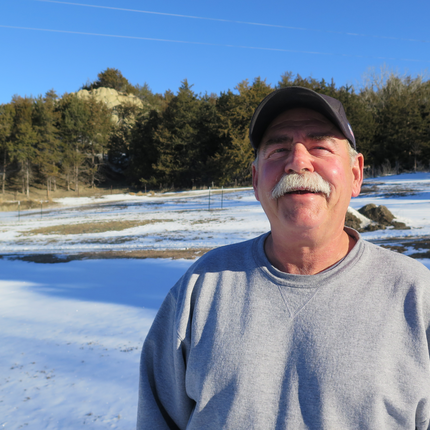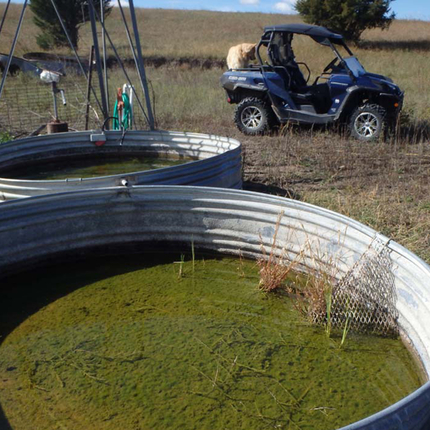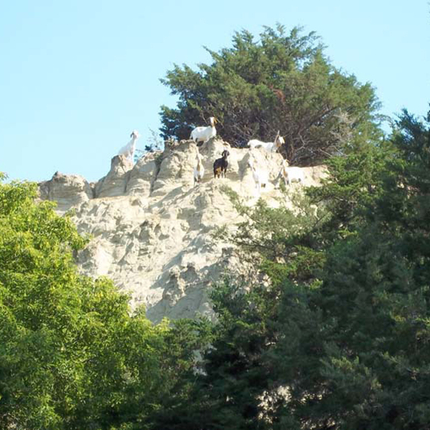Sitting in the office of his auto body shop, Max Wilson brings up satellite photographs of his land on Google Earth. Clicking through a decade of images, a dramatic change unfolds.
“We’re getting back to grass. In 10 years, I can see a lot of change,” he said, referring to the removal of eastern red cedar trees from his pastures. “Now it’s like a grassland instead of a forest.”
Max’s shop and home are located on 1,000 acres just outside of Burwell, Nebraska. The land he inherited from his parents is 80% pasture and 20% farm ground, the two land types divided by deep canyons filled with cedars and other coniferous trees.
As is the case on many Sandhills ranches, the encroaching cedars have been a constant battle. But thanks to several cost-share programs, including the Environmental Quality Incentives Program (EQIP) and the Conservation Stewardship Program (CSP), Max has been able to prioritize conservation efforts to keep his pasture in grass.
EQIP is program that helps farmers and ranchers share the costs of addressing natural resource concerns. A voluntary conservation program administered by the United States Department of Agriculture (USDA) through the Natural Resources Conservation Service (NRCS), EQIP provides financial and technical assistance to agricultural producers to plan and implement conservation practices that improve water, soil, plant, animal, air and related natural resources.
Once enrolled in EQIP, Max worked with the local NRCS office in Burwell to draw up a burn plan for a prescribed burn on his land. They surveyed the pasture area and made a detailed map and plan for the day.
“Then when you get all of your fire department there in the morning, you’ve got it on paper. The office here is a huge help,” he said.
To prepare his pasture for the burn, Max deferred grazing in that area for one growing season, essentially taking it out of production and letting the grass grow for fuel. To be able to afford this, Max applied for a grazing deferment cost share through EQUIP, a program that further incentivizes best practices for cedar reduction.
“The cedar trees never quit coming, so to be paid for deferment is important. A lot of people just won’t do it without the program.”
Fire is just one practice in Max’s conservation tool belt. Max’s land is also enrolled in CSP, which is administered by NRCS and offers farmers the opportunity to earn payments for actively managing, maintaining, and expanding conservation activities like cover crops, buffer strips, and rotational grazing, among many other practices.
One CSP practice that Max recently enrolled in involves monitoring key grazing areas to improve grazing management. This has involved taking pictures of pasture lands to determine plant productivity over time and keeping track of key forage plant heights before and after grazing.
Another CSP practice is Max’s use of goats on his land for the purpose of weed control. Indiscriminate eaters, the goats he leases from a neighbor graze on his unwanted weeds and the roughage off the cedar trees.
“Basically we just turn them loose. They want weeds,” said Max.
In addition, Max installed wildlife escapes or “turtle ramps,” as many Sandhills ranchers call them, another CSP practice that prevents animals from drowning in stock tanks.
Max has prioritized conservation programs for several reasons. One, he wants to leave the land in better shape than he found it; and two, the programs he participates in help him pay the property taxes.
“When I’m gone, this pasture is going to be nicer than I found it - and I think these programs promote that.”
Top photo: Max Wilson on his ranch just outside Burwell. Second photo: wildlife escapes are a simple conservation measure that stop small animals from drowning in water tanks. Third photo: introducing goats is one way to control weeds in problem areas. Photos by Kat Shiffler







